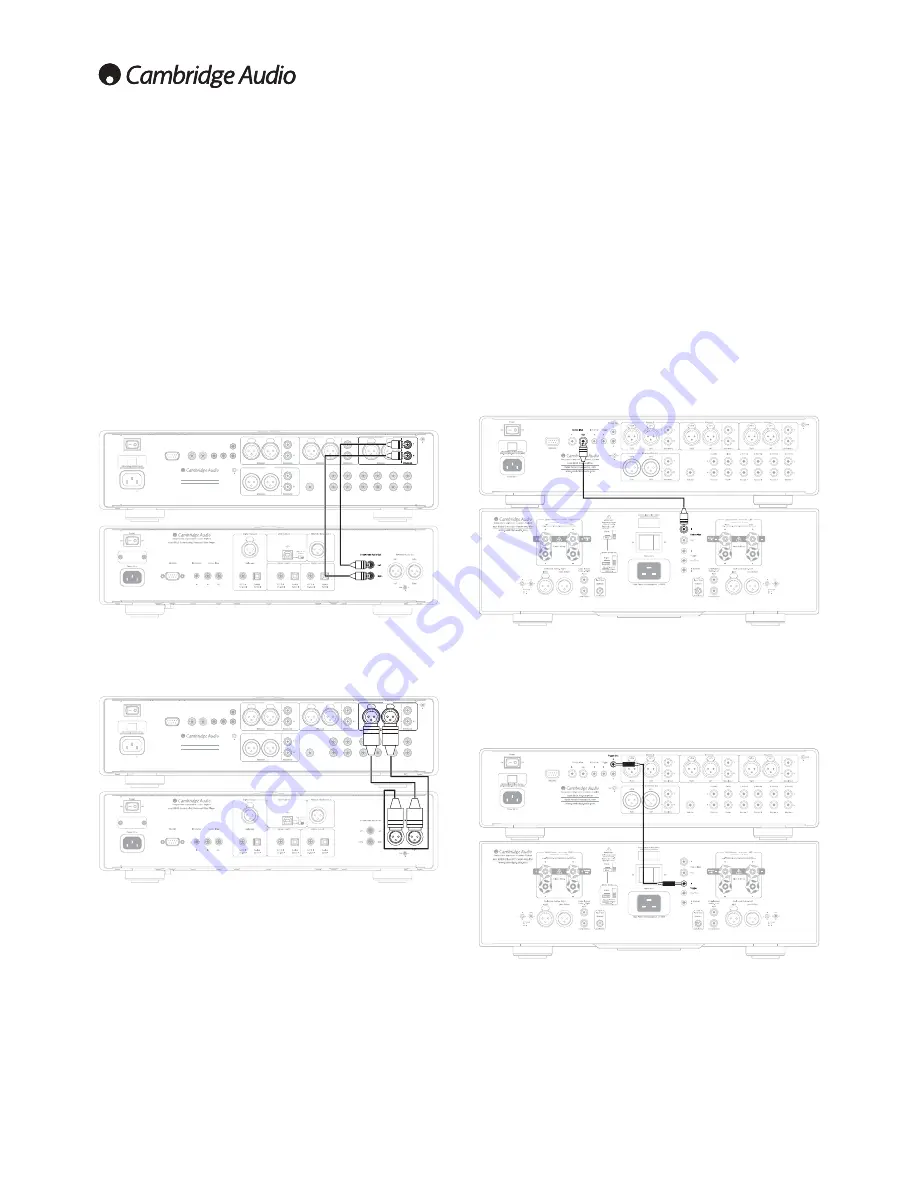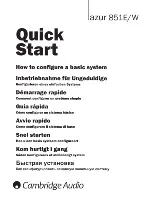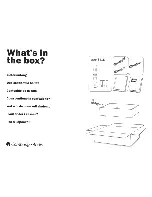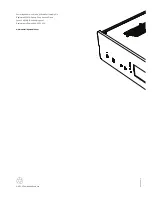
8
Power syncing (On/Standby control)
:KHQJRLQJLQRXWRI6WDQGE\PRGHWKH$]XU(SUHDPSOLÀHUFDQLI
desired) automatically control the 851W when connected via the Control
Bus sockets (the Control Bus sockets are colour-coded orange on the
rear panels of compatible Azur models). For this feature to work the units
must be connected together by RCA/phono leads. No futher setup is
necessary.
Connect the Control Bus Out from the 851E to the Control Bus In on the
851W. Continue the chain to other Azur models if it is required to sync
more units.
Note:
The 851E features a Trigger Out which can alternatively be used to
control the 851W's Standby/On status if desired. Again, the procedure is
simply to connect the two units together (using a 3.5mm to 3.5mm mono
mini-jack lead in this case).
Control Bus connection
Control Bus is the recommended method when using an 851E and other
Cambridge Audio equipment with Control Bus In/Out.
851E
851W
Trigger connection
Trigger In/Out can be useful if the 851W (and indeed 851E) is desired to
be controlled by other equipment that features trigger outputs (Custom
install and/or Multi-Room Systems etc).
851E
851W
Source connections
Source 1, 2 and 3 on the 851E feature either unbalanced (phono/RCA)
or balanced (XLR) connections. The 851E is designed to work at its
highest performance when a balanced interconnect is used.
7KH GLDJUDPV EHORZ VKRZ WKH ( SUHDPSOLÀHU FRQQHFWHG WR DQ
Azur 851C CD player in unbalanced (Figure 1) and balanced (Figure 2)
FRQÀJXUDWLRQV7KH(FDQDOVREHFRQQHFWHGWRQRQ&DPEULGJH$XGLR
sources with balanced outputs.
Balanced connections in an audio system are designed to reject
electrical noise, from power wiring etc, and also the effects of noise
FXUUHQWV ÁRZLQJ WKURXJK JURXQG FRQQHFWLRQV 7KH EDVLF SULQFLSOH RI
balanced interconnection is to get the signal you want by subtraction,
using a three-wire connection. One signal wire (the hot or in-phase)
carries the normal signal, while other (the cold or phase-inverted) carries
an inverted version. The balanced input senses the difference between
the two lines to give the wanted signal. Any noise voltages that appear
identically on both lines (these are called common-mode signals) are
cancelled by the subtraction.
Power AC
R
L
R
L
Trigger Out
2
1
Trigger
In
In
In
Out
Re
c Out
Sub Out
Re
c In
Source
7
Sourc
e6
Sourc
e5
Sour
ce4
Rec Out
Rec In
Source 7
Source 6
Source 5
Source 4
RS232C
Control Bus
IR Emitter
GND
On
Off
Power
GND
azur 851E Pre-Amplifier
Rated Power Consumption
:
36W
www.cambridge-audio.com
Designed and engineered in London, England
Left
Right
Source 3
Source 3
Left
Right
Source 2
Source 2
Left
Right
Source 1
Source 1
Left
Right
Left
Right
(Balanced)
(Unbalanced)
(Balanced)
(Unbalanced)
(Balanced)
(Unbalanced)
(Balanced)
(Unbalanced)
Pre Out
Pre Out
Source 1
(Unbalanced)
Figure 1: Unbalanced input
Phono/RCA
851E
851C
Power AC
R
L
R
L
Trigger Out
2
1
Trigger
In
In
In
Out
Re
c Out
Sub Out
Re
c In
Source
7
Sourc
e6
Sourc
e5
Sour
ce4
Rec Out
Rec In
Source 7
Source 6
Source 5
Source 4
RS232C
Control Bus
IR Emitter
GND
On
Off
Power
GND
azur 851E Pre-Amplifier
Rated Power Consumption
:
36W
www.cambridge-audio.com
Designed and engineered in London, England
Left
Right
Source 3
Source 3
Left
Right
Source 2
Source 2
Left
Right
Source 1
Source 1
Left
Right
Left
Rig
ht
(Balanced)
(Unbalanced)
(Balanced)
(Unbalanced)
(Balanced)
(Unbalanced)
(Balanced)
(Unbalanced)
Pre Out
Pre Out
Left
Right
Source 1
(Balanced)
Figure 2: Balanced input
851E
851C






































